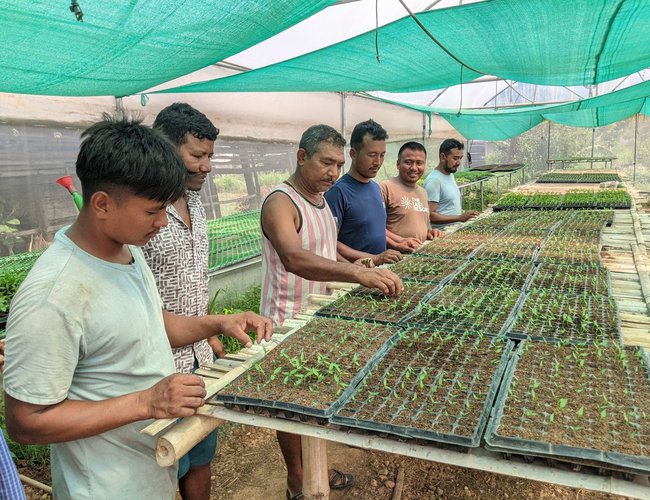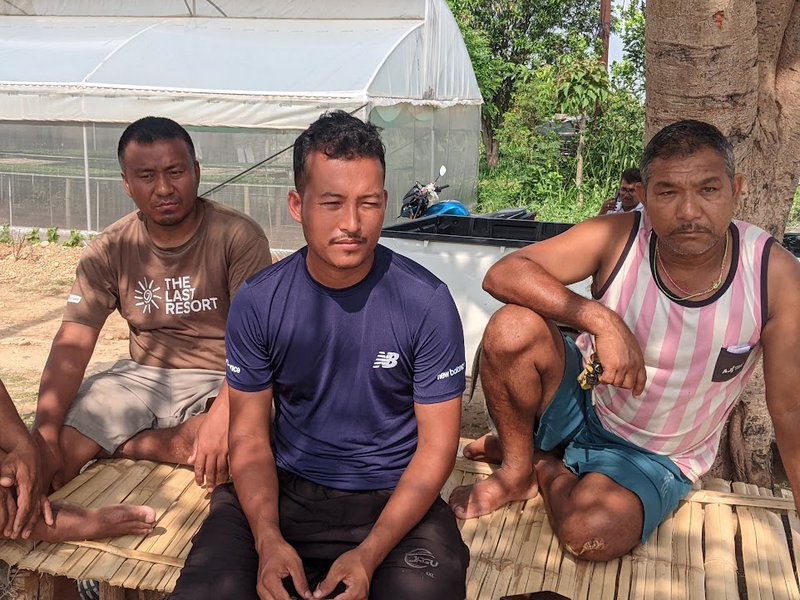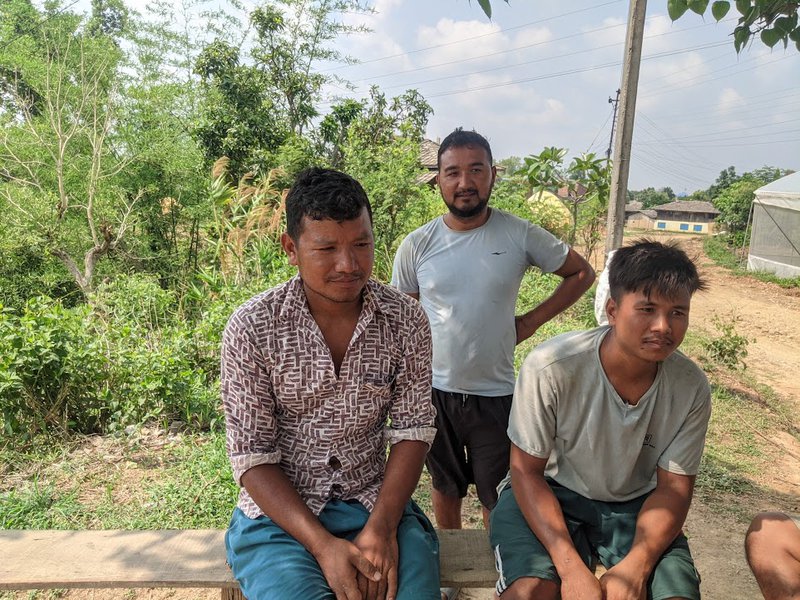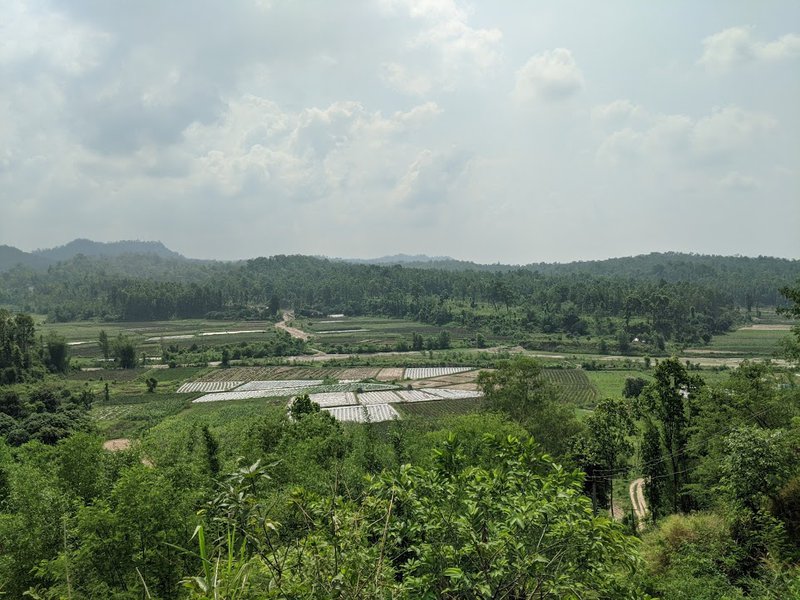
White tunnels can be seen everywhere in Arun Dada village of Bardibas Municipality Ward 10. As part of their daily schedule, the farmers gather at the collection center to engage in commercial vegetable farming. They hold meetings twice a day: in the afternoon to set the prices of their products and in the morning to arrange for delivery.
With the motto "Move forward together for prosperity through commercializing agriculture and generating employment opportunities back home," 27 farmers, led by young returnees from foreign employment, formed the Arun Dada Krishi Samuha in Bardibas Municipality Ward 10, Mahottari, in the Madhesh province, 200 kilometers southeast of Kathmandu.
Recognizing the high demand for tomatoes, cucumbers, beans, chilies, and other seasonal vegetables in major markets such as Kathmandu, Pokhara, and Narayanghat, they started farming with personal investments. Initially, the lack of technical knowledge resulted in poor-quality produce. However, after joining the Samriddhi project and receiving technical and financial support, their production gradually improved.
Marketing posed another challenge. Despite producing ample vegetables, unhealthy competition led to poor pricing. Farmers would undercut each other, selling at half the price to outdo one another. The Samriddhi project facilitated discussions on collective farming and marketing, leading to the establishment of a collection center and the formation of a cooperative group. This initiative solved pricing issues and stabilized the market.
Supported by the Samriddhi project, the youth group achieved their goal of bringing prosperity through the commercialization of agriculture, employing new technologies, and acquiring essential skills.
Led by 29-year-old Bimla Kumar Shrestha, who abandoned his plan to go to Qatar five years ago, a group of farmers has transformed the agricultural landscape in Bardibas Municipality Ward 10. Using the money he had allocated for migration, Shrestha started vegetable farming. With no prior skills, he organized a group of seven individuals, including five returnee migrants, who were willing to invest in the venture.

The first year was frustrating due to poor yields, leaving the group disheartened and contemplating migration again. However, their fortunes changed after meeting experts from the Samriddhi project through Bardibas Municipality. Following the advice from Samriddhi, Shrestha and his six colleagues formed the Kharima Arun Dada Kishan Samuha and participated in training on plastic tunnel construction and modern farming methods.
For the past four years, the farmers' group has been associated with Samriddhi, focusing on developing the supply chain and market linkages. The group has grown to 27 members with a savings of Rs. 300,000 (USD 2,200). Each member contributes Rs. 500 monthly to the savings fund.
"The members can obtain loans from this savings fund at an interest rate of 12 percent, compared to up to 36 percent charged by village moneylenders," Shrestha explained.
With improved skills, technology, and market connections, group members now make an annual net income ranging from Rs. 300,000 (USD 2,500) to Rs. 700,000 (USD 5,500), depending on their land size.
"I focus on vegetable farming, planting tomatoes, green chilies, and beans on my 3 bighas of land," said Tek Bahadur Shrestha, a 50-year-old returnee migrant who invested his savings from Saudi Arabia.
"Learning from our first year's failure, we have all focused on market linkage. Thanks to Samriddhi, we also gained access to technology, markets, and loan guarantees from Women Multipurpose Cooperative Centers."
Over the past four years, Shrestha and his group members have become a perfect example of how the SAMRIDDHI project is transforming the livelihoods of rural communities.
"The meeting with Samriddhi was a turning point for us. After that meeting, I put my new passport away and decided not to go abroad. Following the advice we received, we bought plastic tunnels, changed our planting methods, and adjusted our crop patterns," said Shrestha. Their group alone cultivates vegetables on 20 bighas of land, while non-members farm an additional 5 bighas.
Laxman Shrestha, a 28-year-old returnee migrant, attends the group meetings daily. He invested his savings from foreign employment to purchase land and further invested some of his money into farming. "My hard-earned money from abroad has produced good returns from agriculture and also generated employment for me," he said. Alongside the 27 group members, 35 families are now growing vegetables on a total of 25 bighas (about 18 hectares) of land.
Farming Amidst Climate Change
Like all districts in the Madhesh Province, Mahottari district is grappling with the adverse effects of climate change. Changing rainfall patterns and increasing temperatures are affecting agriculture, making it difficult for farmers to sustain their livelihoods and plan their crops. The skills and techniques learned from SAMRIDDHI have been instrumental in helping them mitigate these impacts.

Additionally, the warming climate has created more hospitable conditions for crop pests and diseases that were not previously a problem, posing a significant challenge for smallholder farmers like Shrestha, whose families rely on agriculture.
Shrestha and his group members have implemented modern climate-resilient practices with support from the SAMRIDDHI project, significantly improving their productivity.
Shrestha's group has also drilled a borehole to irrigate their land and are using environmentally friendly bio-pesticides and bio-fertilizers instead of expensive chemical alternatives. These practices have strengthened their farms' resilience to climate shocks and changes.
Facing a shortage of regular pesticides, Shrestha and his group members have prepared and used "jholmol"—homemade bio-fertilizers and bio-pesticides. Jholmol is not only cost-effective but also eco-friendly, reducing the need for expensive and environmentally damaging chemical fertilizers and pesticides.
These sustainable practices have increased the household incomes of Shrestha and his group members. Last year, each family generated nearly NPR 300,000 to 700,000 (approximately USD 3,050 to USD 5,500) in revenue from selling seasonal vegetables. Connected to the market chain, vendors send vehicles to transport vegetables to wholesale markets in Kathmandu and Pokhara.
Eager to share their success, the group often invites other farmers from nearby areas to visit their farm, where Samriddhi has established a community learning center. Their goal is to raise awareness among fellow farmers about market chain solutions that help increase production and introduce the latest skills and crops.
"The passion and dedication of group members like Shrestha have inspired others to embrace sustainable commercial farming practices. I was unsure about new technology and market access, but when I visited Bimal’s group farm and saw the incredible results firsthand, my doubts vanished," said Pralahad Kumar Chhetri, Mayor of Bardibas Municipality. "RERP and SAMRIDDHI have made a great contribution to making the community prosper by commercializing agriculture. The municipality works in close collaboration with the project."
This success story is not unique. The Rural Enterprises and Remittances Project (RERP) Samriddhi has supported 13,000 households through value chain activities, including 1,400 women social mentors. Of these households, 55 percent are returnee migrants and their families across three provinces.
“The project covers 3 provinces, 16 districts, and 208 local governments, including Bardibas,” said Jiban Shrestha, Migration Coordinator of the RERP/SAMRIDDHI Project. Farmers believe in the immense potential of commercializing agriculture to prevent youth from going abroad and to invest remittances in productive sectors.
“While competitive market prices pose significant threats to small farmers, they confront these challenges head-on with the support of RERP-Samriddhi. With the right measures and sustainable practices, agriculture not only survives but also provides employment opportunities for youth and integrates returnee migrants through their own investments. This is the lesson learned here,” said Sanjeev Kumar Shrestha, National Consultant (Value Chain & Markets) at the International Fund for Agricultural Development (IFAD).
Through their work, the group demonstrates that by prioritizing market access and technology, agriculture can become a force for positive change. Group leader Shrestha also encourages other young individuals to consider pursuing a future in agriculture, emphasizing the importance of commercial farming practices.
At a time when many young people are abandoning agriculture, Shrestha’s story serves as an inspiration, showcasing the potential of using and promoting agricultural practices at home and in the community.
Laxman Shrestha, a 35-year-old returnee migrant, joined the group last year and decided not to go back to Oman. “I came home for a two-month vacation after four years, but seeing the group's success, I decided not to return abroad. If I can make money here, there is no reason to go abroad,” he said.

Not only Laxman Shrestha but also Hira Sunuwar, a 38-year-old returnee migrant, has reintegrated into society by joining the group. "After working for 12 long years in Gulf countries, I purchased some land and joined the group. With 2 bighas of land, I am making an annual income of around NPR 600,000 (USD 5,500). This is more than what I made in Oman," said Hira.
The orientation from the project gave him renewed energy. Through the project, he learned that animal insurance is essential to reduce business risks, along with cage improvement, breed improvement, and feed management, transforming traditional goat rearing into a modern practice.
In Nepal, 65.6 percent of the population is directly or indirectly dependent on agriculture for their livelihood, according to the Ministry of Agriculture and Livestock Development.
The National Youth Policy 2015 also emphasizes the need to encourage youth in the agriculture sector. Approximately 40.35 percent of Nepal's total population falls within the age range of 16-40. This "youth bulge" can serve as a demographic dividend, yet over 14 percent of the youth population is living abroad for employment. Given this situation, youth engagement in agriculture is a prerequisite for sustainable development.
By funding Samriddhi, IFAD has been supporting the Nepal government's target to engage more youth in modern agriculture to increase production and income.
“There is an urgent need to address this situation and ensure that youths work in the country with their futures guaranteed. Youths should be seen as assets for transforming Nepal, utilizing their unique skills and talents in agriculture, instead of pushing them abroad for remittance,” said Sanjeev Kumar Shrestha.
“If agriculture is made remunerative and rewarding in terms of income and profitability, youths will indeed be attracted to the sector,” said the Mayor of Bardibas Municipality. “We highly appreciate the Samriddhi project for encouraging youth in agriculture. Our partnership with Samriddhi is working perfectly.”
“In the last seven years, our project has reintegrated hundreds of migrant returnees into society through agriculture and engaged the youth population in this sector,” said Saroj Prasad Guragain, Project Manager of SAMRIDDHI. “Many still don’t consider it a viable sector for employment, viewing it as highly unattractive due to its associated risks, intensive nature, and low profitability. However, with our project, many young people from our project areas now see a future for themselves in agriculture. Our experience shows that one cannot expect youths to become involved in agriculture without first making it attractive in terms of its image and economic returns.”
To promote youth engagement in agriculture, the first step is to improve its image. Many adults have earned a substantial income through agriculture. These model farms and farmers need to be identified, and their information and experiences shared through various media. Fortunately, there are many educated adults engaged in this sector because they see a promising future in it.
Youth farmers in Bardibas have successfully utilized modern technology and machinery to manage sophisticated farms. They have increased access to information and communications technology, gained knowledge and experience, and observed successful farms abroad. This exposure has given them a keen desire to join the agricultural sector.
The youth farmers in Bardibas have managed to harvest more than traditional farmers per unit area of land. The adoption of high-yield varieties, increased use of fertilizers and irrigation, well-managed plant protection measures, and product selection based on market trends have contributed to their success.
Recognizing that a lack of capital has hindered many youths who have good ideas and knowledge and wish to work in agriculture, the SAMRIDDHI project links youth farmers with cooperatives to address this problem.
The SAMRIDDHI project has successfully integrated an approach to the much-needed revitalization of Nepal's agricultural sector by implementing initiatives aimed at retaining the youth demographic, particularly those aged 21 to 35 years. A significant number of these individuals have pursued employment abroad as migrant laborers, resulting in a substantial brain drain. It is imperative to harness this pool of human resources within the country to drive the broader development of agro-based activities.

Given that a considerable portion of Nepal's dynamic youth has migrated abroad, the government must take proactive measures to encourage their return and provide viable employment opportunities in agriculture.

Keshab Poudel
Poudel is the editor of New Spotlight Magazine.
- KUL MAN GHISING: Bowing Down To The People
- Apr 13, 2025
- POLITICAL VIOLENCE: Culture of Impunity
- Apr 11, 2025
- PM OLI MEETS PM MODI: No Progress
- Apr 09, 2025
- PM OLI’S THAILAND VISIT: Flip Flop
- Apr 08, 2025
- FM Dr. Deuba’s India Visit: Mission Aborted
- Mar 26, 2025














